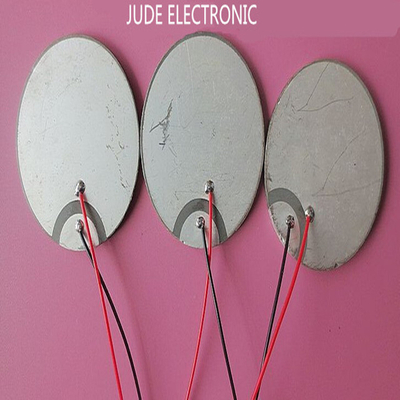
Induced shear strain about direction 2 per unit electric displacement applied in direction 1 Induced electric field in direction 1 (perpendicular to direction in which ceramic element is polarized) per unit shear stress applied about direction 2 (direction 2 perpendicular to direction in which ceramic element is polarized) Induced strain in direction 1 per unit electric displacement applied in direction 3 Induced electric field in direction 3 (parallel to direction in which ceramic element is polarized) per unit stress applied in direction 1 (perpendicular to direction in which ceramic element is polarized) Induced strain in direction 3 per unit electric displacement applied in direction 3 Induced electric field in direction 3 (parallel to direction in which ceramic element is polarized) per unit stress applied in direction 3 Because the strength of the induced electric field produced by a piezoelectric material in response to an applied physical stress is the product of the value for the applied stress and the value for g, g is important for assessing a material's suitability for sensing (sensor) applications. The second subscript is the direction of the applied stress or the induced strain, respectively. The first subscript to g indicates the direction of the electric field generated in the material, or the direction of the applied electric displacement. The piezoelectric voltage constant, g, is the electric field generated by a piezoelectric material per unit of mechanical stress applied or, alternatively, is the mechanical strain experienced by a piezoelectric material per unit of electric displacement applied. Induced shear strain about direction 2 per unit electric field applied in direction 1 Induced polarization in direction 1 (perpendicular to direction in which ceramic element is polarized) per unit shear stress applied about direction 2 (direction 2 perpendicular to direction in which ceramic element is polarized) Induced strain in direction 1 per unit electric field applied in direction 3 Induced polarization in direction 3 (parallel to direction in which ceramic element is polarized) per unit stress applied in direction 1 (perpendicular to direction in which ceramic element is polarized) Induced strain in direction 3 per unit electric field applied in direction 3 Induced polarization in direction 3 (parallel to direction in which ceramic element is polarized) per unit stress applied in direction 3 Because the strain induced in a piezoelectric material by an applied electric field is the product of the value for the electric field and the value for d, d is an important indicator of a material's suitability for strain-dependent (actuator) applications.

The first subscript to d indicates the direction of polarization generated in the material when the electric field, E, is zero or, alternatively, is the direction of the applied field strength. The piezoelectric charge constant, d, is the polarization generated per unit of mechanical stress (T) applied to a piezoelectric material or, alternatively, is the mechanical strain (S) experienced by a piezoelectric material per unit of electric field applied. The piezoelectric charge constant, d, the piezoelectric voltage constant, g, and the permittivity, e, are temperature dependent factors.įigure 1.6 - The direction of positive polarization usually is made to coincide with the Z-axis. Definitions of the most frequently used constants, and equations for determining and interrelating these constants, are summarized here. Direction X, Y, or Z is represented by the subscript 1, 2, or 3, respectively, and shear about one of these axes is represented by the subscript 4, 5, or 6, respectively. The direction of positive polarization usually is made to coincide with the Z-axis of a rectangular system of X, Y, and Z axes ( Figure 1.6). Consequently, each constant generally has two subscripts that indicate the directions of the two related quantities, such as stress (force on the ceramic element / surface area of the element) and strain (change in length of element / original length of element) for elasticity. Because a piezoelectric ceramic is anisotropic, physical constants relate to both the direction of the applied mechanical or electric force and the directions perpendicular to the applied force.


 0 kommentar(er)
0 kommentar(er)
